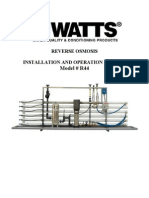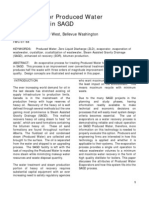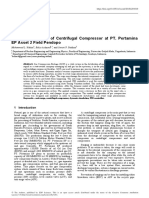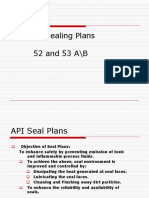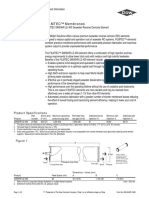0 ratings0% found this document useful (0 votes)
41 views1.1 Operating Conditions: Inspection Report Template
1.1 Operating Conditions: Inspection Report Template
Uploaded by
Subsea_TeamThis inspection report discusses hydrate formation issues for the Setonix Well and outlines methods for prevention and management. The well operates at low seabed temperatures and high pressures, placing it within the hydrate formation region. Key methods for inhibiting hydrate formation include injecting methanol-ethylene glycol to modify the hydrate curve, maintaining high operating temperatures, and minimizing operating pressures. The report also describes startup, shutdown, and removal procedures to address hydrate risks during different operational phases.
Copyright:
Attribution Non-Commercial (BY-NC)
Available Formats
Download as DOCX, PDF, TXT or read online from Scribd
1.1 Operating Conditions: Inspection Report Template
1.1 Operating Conditions: Inspection Report Template
Uploaded by
Subsea_Team0 ratings0% found this document useful (0 votes)
41 views3 pagesThis inspection report discusses hydrate formation issues for the Setonix Well and outlines methods for prevention and management. The well operates at low seabed temperatures and high pressures, placing it within the hydrate formation region. Key methods for inhibiting hydrate formation include injecting methanol-ethylene glycol to modify the hydrate curve, maintaining high operating temperatures, and minimizing operating pressures. The report also describes startup, shutdown, and removal procedures to address hydrate risks during different operational phases.
Original Description:
Original Title
Write up
Copyright
© Attribution Non-Commercial (BY-NC)
Available Formats
DOCX, PDF, TXT or read online from Scribd
Share this document
Did you find this document useful?
Is this content inappropriate?
This inspection report discusses hydrate formation issues for the Setonix Well and outlines methods for prevention and management. The well operates at low seabed temperatures and high pressures, placing it within the hydrate formation region. Key methods for inhibiting hydrate formation include injecting methanol-ethylene glycol to modify the hydrate curve, maintaining high operating temperatures, and minimizing operating pressures. The report also describes startup, shutdown, and removal procedures to address hydrate risks during different operational phases.
Copyright:
Attribution Non-Commercial (BY-NC)
Available Formats
Download as DOCX, PDF, TXT or read online from Scribd
Download as docx, pdf, or txt
0 ratings0% found this document useful (0 votes)
41 views3 pages1.1 Operating Conditions: Inspection Report Template
1.1 Operating Conditions: Inspection Report Template
Uploaded by
Subsea_TeamThis inspection report discusses hydrate formation issues for the Setonix Well and outlines methods for prevention and management. The well operates at low seabed temperatures and high pressures, placing it within the hydrate formation region. Key methods for inhibiting hydrate formation include injecting methanol-ethylene glycol to modify the hydrate curve, maintaining high operating temperatures, and minimizing operating pressures. The report also describes startup, shutdown, and removal procedures to address hydrate risks during different operational phases.
Copyright:
Attribution Non-Commercial (BY-NC)
Available Formats
Download as DOCX, PDF, TXT or read online from Scribd
Download as docx, pdf, or txt
You are on page 1of 3
Inspection Report Template <<Add client logo>>
1 Introduction
Due to the operating condition of the Setonix Well, hydrate formation will be a significant
issue in the production of the hydrocarbon. This is due to the relatively low seabed
temperature and high operating pressure. The following diagram illustrates the operating
region in which hydrates are expected to form.
Figure 1 Hydrate Curves for Perth Canyon Crude (Setonix Basis of Design 2010)
1.1 Operating Conditions
The Perth Canyon Reservoir is will have 8 wells arranged to maximise production rate.
Due to the low pressure, the well will be supported by a support system that can pump
the hydrocarbon to the surface.
Although the reservoir operates at a high temperature, it is the operating temperature of
the wellhead and pipeline indicates a significant threat of hydrates formations. The
following table outlines the operating conditions at the wellhead of each well.
Initially, as the production fluid is drawn out of the well, it will undergo significant cooling
to the seabed temperature during the life of the project. From the data, we can conclude
that the seabed temperature ranges from _____ to _____, with an annual average
temperature of _____.
To ensure the hydrate formation margin is as small as possible, the operator will
continuously minimise the operating pressure to be as low as possible. This is ideal
because it will enable production with a lower temperature for the same amount of
inhibitors and gas rate. It is expected that the produced water will increase over the life
of the project and as such, a higher dosage of inhibitor will be added in proportion to this
increase.
XX/XX/XX/XXXX | Revision: X Page 1 of 3
Inspection Report Template <<Add Client logo>>
1.2 Outline of the Facilities Required
With the FPSO as the production facility, the following assets are required to maintain the
injection of the inhibitors:
Inhibitor injection system
Corrosion Inhibitor dosing
Inlet separation facilities
Methyl Ethylene Glycol regeneration facilities
Inhibitor storage
Injection monitoring system
Water processing equipment
The inhibitor injection system will include a variable rate positive displacement pump that
is connected to the production line via umbilicals. Each outlet will have with it a metering
panel that measures the flow rate as well as the pressure in each injection line. It is ideal
that the maximum injection rate is maintained at all times to ensure a safe hydrate
margin.
In conjunction with the MEG, a corrosion inhibitor will also be dosed into the production
line. However, it is imperative that the corrosion inhibitor is maintained at a level of 1000
ppm in the MEG solution. Overdosing the corrosion inhibitor can potentially interfere with
the hydrate management system.
Inlet separation facilities are required to separate the MEG/corrosion inhibitor from the
production fluid. The separated MEG/corrosion inhibitor can then be directed into the MEG
regeneration facilities. Water is removed in this system and the corrosion inhibitor will
remain within the MEG solution. Inhibitor storage will then contain the available inhibitor
and corrosion to ensure steady application into the system.
Furthermore, the injection monitoring system will assess the rate of injection and return
of the MEG and corrosion inhibitor. The concentration of the MEG will be measured by a
density meter and adjustment will be made depending on the concentration within the
system.
1.3 Hydrate Inhibition Methods
Several methods will be employed to ensure that hydrates formation is prevented. The
following table outlines these methods:
Method Type of intervention Purpose
MEG injection Thermodynamic Modify the hydrate
formation curve
Elevate operating Operational Prevent production fluid to
temperature enter hydrate formation
curve
Minimize operating Operational Prevent production fluid to
temperature enter formation curve
Page 2 of 3 XX/XX/XX/XXXX | Revision: X
Inspection Report Template <<Add client logo>>
1.4 Hydrate Management during Start-up and Shut-down
During start-up operation, MEG should be pumped into the wellbore to inhibit the fluids
from forming hydrates. Additionally the injection of methanol will dissolve any hydrate
particles before it becomes sufficiently large to block the system.
Prior to shut-down operations, the production system should operate at lower rates. The
addition of MEG will inhibit the hydrate formation and assist with the re-start operation of
the system.
In the event of an unplanned shut-down, flaring should be conducted to lower the
concentration of the methane gas. MEG should also be injected into the system to inhibit
the cooling fluid from forming hydrate particles.
1.5 Hydrate Removal
Upon hydrate detection, depressuration should be conducted. However, in the event of
complete hydrate blockage, the pipeline should be depressurised slowly at both ends of
the pipeline. This is conducted to stop large pressure difference between the two end of
the pipeline which will propel the hydrates along the pipeline and can potentially rupture
the pipeline.
XX/XX/XX/XXXX | Revision: X Page 3 of 3
You might also like
- Oil Tanker Operations PDFDocument253 pagesOil Tanker Operations PDFSaurabh Yadav80% (5)
- Uso Soda TecnicoDocument5 pagesUso Soda Tecnicounmsm1000No ratings yet
- AccumulatorsDocument5 pagesAccumulatorspaplus50% (2)
- How Industrial Businesses Can Reduce Production Costs With Reverse Osmosis: Industrial Reverse OsmosisFrom EverandHow Industrial Businesses Can Reduce Production Costs With Reverse Osmosis: Industrial Reverse OsmosisRating: 5 out of 5 stars5/5 (1)
- AIChE (Design Guidelines For Subsea Oil Systems)Document17 pagesAIChE (Design Guidelines For Subsea Oil Systems)platipus_85100% (1)
- WP01081S00EN0218Document12 pagesWP01081S00EN0218Jose Manuel MatossNo ratings yet
- American Greenfuels Standard Operating Procedure 30-10-0002 Methanol Column Operation & ControlDocument18 pagesAmerican Greenfuels Standard Operating Procedure 30-10-0002 Methanol Column Operation & ControlRahayu WulandariNo ratings yet
- HEI-IMS-CHEM-SOP10 Sodium Hypochlorite Plant OperationDocument8 pagesHEI-IMS-CHEM-SOP10 Sodium Hypochlorite Plant Operationrizwan chNo ratings yet
- Application of Extended HazopDocument10 pagesApplication of Extended HazopTonga ProjectNo ratings yet
- Reverse Osmosis R24-SERIES Installation InstructionsDocument44 pagesReverse Osmosis R24-SERIES Installation InstructionsWattsNo ratings yet
- Nitrogen Tank Blanketing 0415Document4 pagesNitrogen Tank Blanketing 0415NursahidNo ratings yet
- MPP PO ItalyDocument11 pagesMPP PO ItalyUmar Ijaz KhanNo ratings yet
- Reverse Osmosis Model # R48 Installation InstructionsDocument30 pagesReverse Osmosis Model # R48 Installation InstructionsWatts0% (1)
- With Membrane Technolgy For Oil Sands and Power Generation ApplicationsDocument8 pagesWith Membrane Technolgy For Oil Sands and Power Generation ApplicationsMarcelo Varejão CasarinNo ratings yet
- Itmconf Cccar2022 03019Document5 pagesItmconf Cccar2022 03019Sumya Ben mahmoudNo ratings yet
- Reverse Osmosis Model #R44 Installation InstructionsDocument40 pagesReverse Osmosis Model #R44 Installation InstructionsWatts100% (1)
- Design PI Controller For TankDocument11 pagesDesign PI Controller For TankabhinavparkheNo ratings yet
- DX System Installation Guide - v2.0Document22 pagesDX System Installation Guide - v2.0Kim WongNo ratings yet
- CT&Ftank PDFDocument15 pagesCT&Ftank PDFDanivian HigginsNo ratings yet
- Reverse Osmosis: Boiler Water Operator Training NotesDocument6 pagesReverse Osmosis: Boiler Water Operator Training NotesSheikh SahabNo ratings yet
- Reverse Osmosis R12-Wall Mount Installation InstructionsDocument15 pagesReverse Osmosis R12-Wall Mount Installation InstructionsWattsNo ratings yet
- Data Sheet Sw30hrle-400Document2 pagesData Sheet Sw30hrle-400Alexis Antonio Jara VidalNo ratings yet
- SPE 69708 Experiences Using An ESP Application On Heavy-Oil Cold-Production Automation in Eastern Venezuela FieldsDocument3 pagesSPE 69708 Experiences Using An ESP Application On Heavy-Oil Cold-Production Automation in Eastern Venezuela FieldsM.No ratings yet
- Technologies Optimize Flow AssuranceDocument7 pagesTechnologies Optimize Flow AssuranceManus AgereNo ratings yet
- Technical Aspects of Desalination PlantDocument12 pagesTechnical Aspects of Desalination PlantMonica UrbietaNo ratings yet
- Guidelines For Produced Water Evaporators in SAGD 2007Document16 pagesGuidelines For Produced Water Evaporators in SAGD 2007pipedown456No ratings yet
- Process Dynamics of AntiSurge SystemDocument7 pagesProcess Dynamics of AntiSurge SystemBodhisatya DasNo ratings yet
- NHT Amine Degrease Procedure Rev2Document29 pagesNHT Amine Degrease Procedure Rev2raj kumarNo ratings yet
- Ets R01 3223 - Quote For Upgradation of Effluent Treatment Plant - Digdaga FarmDocument14 pagesEts R01 3223 - Quote For Upgradation of Effluent Treatment Plant - Digdaga FarmAbd BkarNo ratings yet
- Process Control SystemDocument20 pagesProcess Control SystemObi Augustine Azubike75% (4)
- Spe 174148 MS 2Document18 pagesSpe 174148 MS 2Hernando CarrilloNo ratings yet
- Reverse Osmosis R14-SERIES Installation InstructionsDocument44 pagesReverse Osmosis R14-SERIES Installation InstructionsWattsNo ratings yet
- Tertiary Recovery - Enhanced Oil Recovery (Eor)Document41 pagesTertiary Recovery - Enhanced Oil Recovery (Eor)Purnima ChouhanNo ratings yet
- Reverse Osmosis Model R4X40 Installation InstructionsDocument16 pagesReverse Osmosis Model R4X40 Installation InstructionsWattsNo ratings yet
- Chilled-water-System-Chemical-Treatment (تصور بسيط)Document12 pagesChilled-water-System-Chemical-Treatment (تصور بسيط)mohamed samirNo ratings yet
- Process Description: Venezuela Jose Mixing Plant Wastewater Treatment Package Equipment (PK-1330330)Document20 pagesProcess Description: Venezuela Jose Mixing Plant Wastewater Treatment Package Equipment (PK-1330330)Erick 27 LibreNo ratings yet
- IPTC-20219-MS A Systematic Approach To Increase Banyu Urip Crude OilDocument15 pagesIPTC-20219-MS A Systematic Approach To Increase Banyu Urip Crude OilGilbert OmittaNo ratings yet
- Case AptiTune Refining Tuning Case Study HCU Quench ValvesDocument3 pagesCase AptiTune Refining Tuning Case Study HCU Quench ValvesJesse Haney IIINo ratings yet
- Clean Fuel TechnologyDocument7 pagesClean Fuel TechnologyGarry DavidNo ratings yet
- Seal Plans Presentation2Document21 pagesSeal Plans Presentation2venkeekuNo ratings yet
- White Paper Impact of Failed Steam Traps On Process Plants en 1258726Document10 pagesWhite Paper Impact of Failed Steam Traps On Process Plants en 1258726Sándor MucsiNo ratings yet
- Flow Assurance HomeworkDocument9 pagesFlow Assurance HomeworkLívia Costa Mello100% (1)
- M-Seal API Sealing Plans 52 and 53 A - BDocument21 pagesM-Seal API Sealing Plans 52 and 53 A - BBindu joglekarNo ratings yet
- SPE 90688 Dilution Strategies For Wax Management and Control For Deepwater Development From A Flow Assurance Perspective: Part - Current Practice and PerspectiveDocument13 pagesSPE 90688 Dilution Strategies For Wax Management and Control For Deepwater Development From A Flow Assurance Perspective: Part - Current Practice and PerspectiveBlackCounterNo ratings yet
- Article - 1001293 Controling FoulingDocument9 pagesArticle - 1001293 Controling FoulingDavid Diaz PadillaNo ratings yet
- Production EngineeringDocument36 pagesProduction EngineeringMuhammad Ali BuriroNo ratings yet
- Generox™ CSR: A Total Control Program Providing Safe and Economical DisinfectionDocument4 pagesGenerox™ CSR: A Total Control Program Providing Safe and Economical Disinfectionjuan pablo suarezNo ratings yet
- Matching Antisurge Control Valve Performance With Integrated Turbomachinery Control SystemsDocument4 pagesMatching Antisurge Control Valve Performance With Integrated Turbomachinery Control SystemsPankaj TiwariNo ratings yet
- 04-2429H - Coolant System GuidelinesDocument12 pages04-2429H - Coolant System GuidelinesAdeel RazaNo ratings yet
- Matching ASC Valve Performance With Integrated Turbomachinery Control System PDFDocument4 pagesMatching ASC Valve Performance With Integrated Turbomachinery Control System PDFfri_13th100% (1)
- 10 - Filmtech MembraneDocument2 pages10 - Filmtech MembraneAnonymous XbmoAFtINo ratings yet
- Water Treatment Guideline - 1Document28 pagesWater Treatment Guideline - 1SofyanNo ratings yet
- Maintenance and Reliability: Process Control and InstrumentationDocument6 pagesMaintenance and Reliability: Process Control and InstrumentationEjubNo ratings yet
- Viadana 2012Document7 pagesViadana 2012Mahfoud AMMOURNo ratings yet
- APEX Deoiler HydrocycloneDocument9 pagesAPEX Deoiler HydrocycloneChem.EnggNo ratings yet
- Paper No.: Elucidating The Corrosion Phenomena in A Thermal in Situ Oil Sands Emulsion PipelineDocument15 pagesPaper No.: Elucidating The Corrosion Phenomena in A Thermal in Situ Oil Sands Emulsion PipelinetinovelazquezNo ratings yet
- Recuperacion MejoradaDocument55 pagesRecuperacion MejoradaChristian Ordoñez PantaNo ratings yet
- Cs Phar Indww en 1106 Na Ge LogoDocument2 pagesCs Phar Indww en 1106 Na Ge Logoanandhra2010No ratings yet
- IPTC 10924 Analyzing Microbial Improved Oil Recovery Processes From Core FloodsDocument8 pagesIPTC 10924 Analyzing Microbial Improved Oil Recovery Processes From Core FloodsSajad FalahNo ratings yet
- Diagnosis and Robust Control of Complex Building Central Chilling Systems for Enhanced Energy PerformanceFrom EverandDiagnosis and Robust Control of Complex Building Central Chilling Systems for Enhanced Energy PerformanceNo ratings yet
- Introduction to Petroleum Process SafetyFrom EverandIntroduction to Petroleum Process SafetyRating: 3 out of 5 stars3/5 (2)
- RisersDocument3 pagesRisersSubsea_Team100% (1)
- Flexible Riser (Abdul Rahman)Document5 pagesFlexible Riser (Abdul Rahman)Subsea_TeamNo ratings yet
- Environmental Summary: Setonix Oil Company Perth Canyon DevelopmentDocument9 pagesEnvironmental Summary: Setonix Oil Company Perth Canyon DevelopmentSubsea_TeamNo ratings yet
- Setonix ProjectDocument5 pagesSetonix ProjectSubsea_TeamNo ratings yet
- Gate 1995 PDFDocument12 pagesGate 1995 PDFVammsy Manikanta SaiNo ratings yet
- Method of Statement Concrete CoringDocument3 pagesMethod of Statement Concrete CoringMuneer ahmed0% (1)
- Vinod Chem 534 Sp15Document4 pagesVinod Chem 534 Sp15Shantam TandonNo ratings yet
- Heat Dissipation in Sealed Electrical Enclosures: Sealed Enclosure Temperature RiseDocument6 pagesHeat Dissipation in Sealed Electrical Enclosures: Sealed Enclosure Temperature RiseĐào Mạnh LượngNo ratings yet
- File 11. Power Gen Course ExcercisesDocument9 pagesFile 11. Power Gen Course Excercisesnabil160874No ratings yet
- SC Fact Sheet HP-Oxygen enDocument1 pageSC Fact Sheet HP-Oxygen enTaha OpedNo ratings yet
- Exhaust Manifold PDFDocument2 pagesExhaust Manifold PDFKimberly100% (1)
- Cool Machines CM 700 Insulation Blowing Machine DatasheetDocument4 pagesCool Machines CM 700 Insulation Blowing Machine Datasheetbrooklynarmstrong487No ratings yet
- Chapter 2Document60 pagesChapter 2Fatih İnalNo ratings yet
- Drive Unit DUc RE15326Document64 pagesDrive Unit DUc RE15326H.J. OsorioNo ratings yet
- TLE4275 q1Document28 pagesTLE4275 q1GG Módulos AutomotivosNo ratings yet
- Economic, Environmental, and Societal IssuesDocument15 pagesEconomic, Environmental, and Societal IssuesPatricia de LeonNo ratings yet
- Sun2000 40KTL M3Document2 pagesSun2000 40KTL M3Imam TyoNo ratings yet
- GK CapsuleDocument118 pagesGK CapsuleJai100% (1)
- 1 s2.0 S1005030215002108 MainDocument9 pages1 s2.0 S1005030215002108 MainDr. Rachid djoudjouNo ratings yet
- Questions For ElectricianDocument87 pagesQuestions For ElectricianMohammad TammamNo ratings yet
- Flownex Applications On CCSDocument8 pagesFlownex Applications On CCSSanthosh LingappaNo ratings yet
- Full Download Book Damage Modeling of Composite Structures Strength Fracture and Finite Element Analysis PDFDocument41 pagesFull Download Book Damage Modeling of Composite Structures Strength Fracture and Finite Element Analysis PDFandrew.reese950100% (29)
- EMERSON Motor TerminologyDocument2 pagesEMERSON Motor TerminologyNikolaNo ratings yet
- Impact of Stockholm ConferenceDocument8 pagesImpact of Stockholm ConferenceAarooni ThakurNo ratings yet
- MBRA130LT3G, NRVBA130LT3G Surface Mount Schottky Power RectifierDocument5 pagesMBRA130LT3G, NRVBA130LT3G Surface Mount Schottky Power RectifierMatt0809No ratings yet
- Fact Sheet Cat JDocument2 pagesFact Sheet Cat JjasleenchhabraNo ratings yet
- PDS33 Solar Pumping System User ManualDocument46 pagesPDS33 Solar Pumping System User Manualmohamed husseinNo ratings yet
- Burroughs B200 Planning Manual - 1972Document53 pagesBurroughs B200 Planning Manual - 1972Delbert RicardoNo ratings yet
- Tax Invoice: Your ElectricityDocument2 pagesTax Invoice: Your ElectricityPavan Kalyan UngaralaNo ratings yet
- Smoke Detector ConventionalDocument1 pageSmoke Detector ConventionalchandialucasNo ratings yet
- Ground Floor Plan: Existing Fcu-01 1-SCD 600X600 MM, NECK 150X150 MM 30 L/S Per EachDocument1 pageGround Floor Plan: Existing Fcu-01 1-SCD 600X600 MM, NECK 150X150 MM 30 L/S Per Eachmhmedgomaa74No ratings yet
- Effects of Electromagnetic Compatibility (Emc) On Human Life, Plant and EquipmentDocument10 pagesEffects of Electromagnetic Compatibility (Emc) On Human Life, Plant and EquipmentMwauraNo ratings yet
- Test For The Presence of Starch in A LeafDocument8 pagesTest For The Presence of Starch in A LeafNathanNo ratings yet















